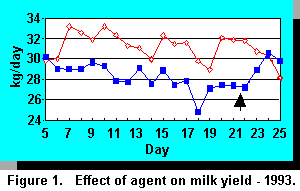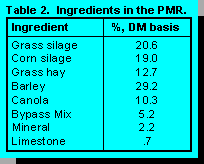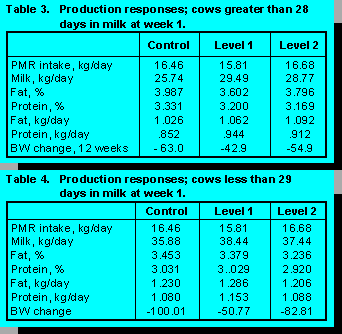New Technologies
Ruminant nutrition is dependent upon efficient microbial digestion of feedstuffs. To date there has been limited ability to alter the efficiency of this process. Ionophores stand out as one method that has consistently given a positive response in animal performance. However, there are limitations on the use of ionophores and some negative connotations in terms of public perception. Over the past four years a graduate student at the University of British Columbia has been investigating, using in vitro systems, a compound that enhances enzyme and microbial action. This compound is widely accepted in food processing and is effective at low concentrations.
In Vitro Studies
Initial studies looked at the effect of the agent on a crude preparation of enzymes isolated from rumen bacteria by the method of Mahadevan (2). Proteolytic activity was increased up to 80% above that of the controls when the agent was included in the assay mix. Using a preparation described by Forsberg (1) and a cellulose assay method developed by Updergraff (3) the effect of the agent on cellulolytic activity was determined. The agent was found to enhance the initial rate of degradation of cellulose by 75%.
Preliminary Lactation Trial
In order to determine if these results would translate into animal performance a very quick (21 days on feed) dairy trial was run using 16 cows (8 cows on the control concentrate and 8 cows on the treated). The agent was incorporated into the concentrate which was fed to the animals via a computer controlled grain feeder at a ratio of 1 kg per 3 kg of milk. The animals were fed free choice alfalfa hay and intake of the hay by individual animals was not measured. Milk samples were taken during the last week of the trial for fat and protein analyses. Milk production was measured daily.
 As can be seen in the Figure 1 there was an immediate response in milk yield by the animals. It
can also be seen that the milk production response dropped off quickly when the animals were
taken off the treated feed on day 22. The control animals were switched to the treated concentrates
for a few days until the treated feed ran out and it could be seen that they also responded very
quickly with increased production. In this short trial the production response was 3.22 kg/day.
Milk fat was depressed and milk protein was slightly improved. Milk per kg of concentrate was
improved with the addition of the agent. These results confirmed the laboratory work and
encouraged further work on mechanisms and more controlled lactation trials. A large number of
laboratory trials have been, and are being, run at UBC and Lethbridge on mechanisms of action.
These laboratory trials will provide guidelines on where the agent will be most economically used.
These type of trials are much cheaper to run than large lactation trials, but ultimately treatments
must be tested in lactating animals.
As can be seen in the Figure 1 there was an immediate response in milk yield by the animals. It
can also be seen that the milk production response dropped off quickly when the animals were
taken off the treated feed on day 22. The control animals were switched to the treated concentrates
for a few days until the treated feed ran out and it could be seen that they also responded very
quickly with increased production. In this short trial the production response was 3.22 kg/day.
Milk fat was depressed and milk protein was slightly improved. Milk per kg of concentrate was
improved with the addition of the agent. These results confirmed the laboratory work and
encouraged further work on mechanisms and more controlled lactation trials. A large number of
laboratory trials have been, and are being, run at UBC and Lethbridge on mechanisms of action.
These laboratory trials will provide guidelines on where the agent will be most economically used.
These type of trials are much cheaper to run than large lactation trials, but ultimately treatments
must be tested in lactating animals.
Mechanisms
One trial recently completed at Lethbridge by Dr. Cheng and his team indicated why a positive response was found in the lactating cow trial. Using an in vitro system it was found that the ratio of volatile fatty acids produced in the rumen was altered by the agent. Total volatile fatty acids were increased. Acetate production was not changed, but the proportion of propionate was increased significantly. Propionate is associated with increased efficiency. A further improvement was found in the gas produced by the organisms. The amount of gas produced by a given amount of feedstuff was reduced with the addition of the agent. These results are consistent with the findings of the short lactation trial where there was an apparent increase in efficiency of feed use. The lower fat production also would be expected from higher levels of propionate production.
Lactation Trial
 We have just finished a large lactation trial at the University farm at Oyster River on Vancouver
Island. In this trial 109 lactating cows were ranked according to production and divided randomly
into three even groups. Two levels of the agent were compared with the control. In Table 1 there is
a listing of the composition of the main ingredients and the partial mixed ration (PMR) designed
to meet production requirements up to 29 kg milk per day. Animals producing above that level
were supplemented with concentrate (treated with the appropriate level of agent) via computer
controlled grain feeders at the rate of 1 kg for every 3 kg of milk above 29 kg per day. The
composition of the concentrate is also given in Table 1.
We have just finished a large lactation trial at the University farm at Oyster River on Vancouver
Island. In this trial 109 lactating cows were ranked according to production and divided randomly
into three even groups. Two levels of the agent were compared with the control. In Table 1 there is
a listing of the composition of the main ingredients and the partial mixed ration (PMR) designed
to meet production requirements up to 29 kg milk per day. Animals producing above that level
were supplemented with concentrate (treated with the appropriate level of agent) via computer
controlled grain feeders at the rate of 1 kg for every 3 kg of milk above 29 kg per day. The
composition of the concentrate is also given in Table 1. The components in the PMR are shown in Table 2. The PMR was fed twice daily with refusals recorded in the morning. Animals were fed at a level that would result in at least 5% refusal.

Milk production was recorded at each milking. Group feed intake was measured each day. Body weights and condition scores were taken on a weekly basis. This trial was run for a 12 week period.
The data was analyzed as two groups. The main group had 80 animals that were at least 30 days in milk at the start of the trial. There were animals in excess of 200 days in milk in this group, but there were no animals in the last trimester of pregnancy during the final week of the trial. The PMR intake is shown in Table 3. This is an over-simplification as all fresh and the main group of animals were housed together and the intake represents an average value for all animals. The milk production responses are dramatic as shown in Table 3. Fat test was significantly lower with Level 1 treatment than the controls. Protein level was approaching significance with the Level 1 treatment and was significantly lower with level 2. Body weight loss over the duration of the trial is worrisome in that the majority of these animals should have been maintaining or gaining weight. It must be pointed out that the inclusion of the agent significantly decreased the amount of body weight loss.

The results shown in Table 4 are for the 29 animals that were less than four weeks in milk at the start of the trial. Included in each group were animals that had not calved at the start date. Milk production is also significantly improved for the treatment groups, with each group being significantly different from the other. If one reanalyzes this data looking at production from the fourth week of the trial onwards, the production responses are higher. By the fifth week the production difference between the Control and Level 1 groups was 3.7 kg/day. It has been observed in trials with enzymes to enhance ration utilization that a similar lag in response existed.
Bottom Line
 The most critical aspect of the trial is to look at what happens to profitability. Using milk values of
$50 per hL, the changes in income associated with the three treatments were calculated. Fat levels
were used to correct the value of the milk and feed costs were assumed constant per kg of PMR.
The most critical aspect of the trial is to look at what happens to profitability. Using milk values of
$50 per hL, the changes in income associated with the three treatments were calculated. Fat levels
were used to correct the value of the milk and feed costs were assumed constant per kg of PMR.
With the cows greater than 28 days in milk at the start of the 12 week trial there were considerable advantages to the inclusion of the agent at the lower level (Table 5). Some caution should be utilized in using these numbers as there are still a number of unknowns. What is the optimal level of the agent? What will the cost of the agent be? How adequate were the diets that these animals were consuming? However, even with these questions there is considerable room for optimism.
Responses of the early lactation animals were not as great. When weekly responses are looked at it appears as if there was a lag in production in early lactation. By the fifth week of lactation there is a greater milk response than that found it the later lactation animals. Similar types of responses have also been found in some of the work on enzyme inclusion in lactating cow diets.
Summary
In summary the agent used at UBC appears to have great potential application in ruminant rations. The mode of action is explained through increased enzyme activity and longevity. The improvement in enzyme action translates into altered ratios of rumen volatile fatty acids resulting in greater efficiency of feed utilization. Two lactation trials have found significant improvements in milk yield. Economic responses are very favorable. Further work needs to be done to determine optimum levels of the agent and the accompanying effects on supply of other nutrients.
Acknowledgements
The lactation trial was funded jointly by ProForm Feeds Inc., Alberta Milk Producers, BCMAFF Partners in Progress Program, and B.C. Milk Producers Association.
Additional Readings
WCDS-1995:Silage Additives - Profit Makers or Profit Takers?
References
1. Forsberg, C.W. 1978. Some effects of arsenic on the rumen microflora: an in vitro study. Can. J. Microbiol. 24:36.2. Mahadevan, S., F.D. Sauer and J.D. Erfle. 1987. Preparation of protease from mixed rumen microorganisms and its use for the in vitro determination of the degradability of true protein in feedstuffs. Can. J. Anim. Sci. 57:55.
3. Updergraff, D.M. 1969. Semimicro determination of cellulose in biological materials. Analytical Biochem. 32:420.